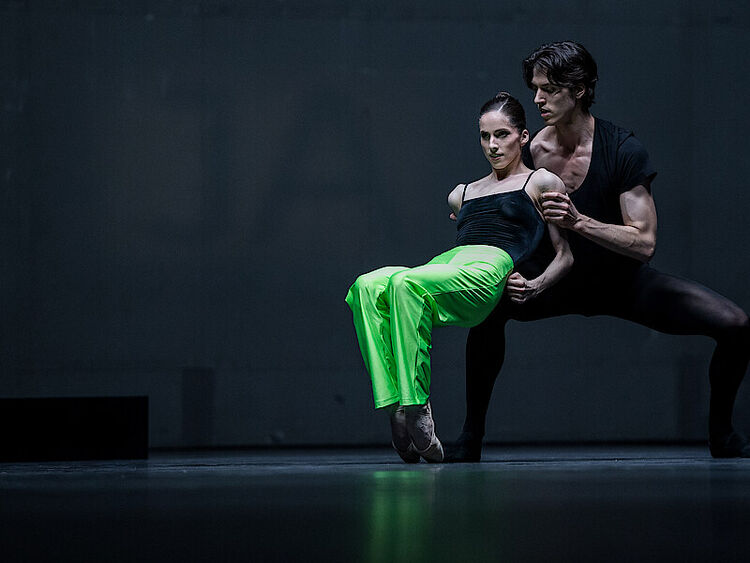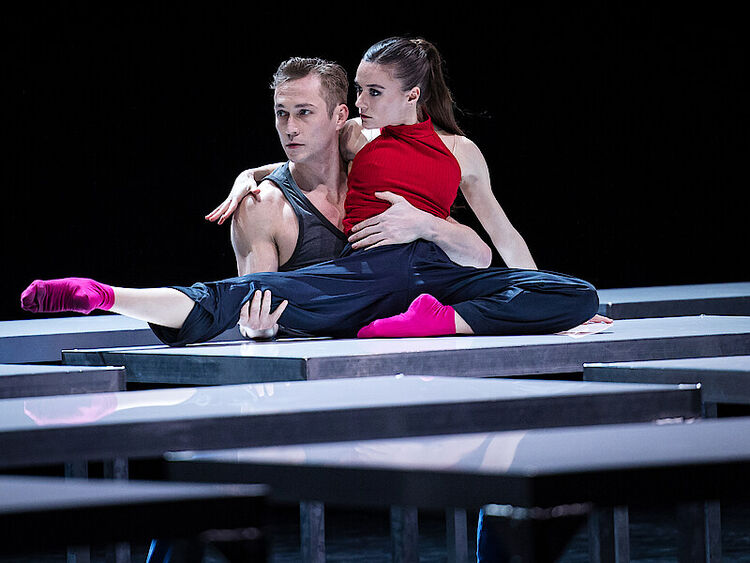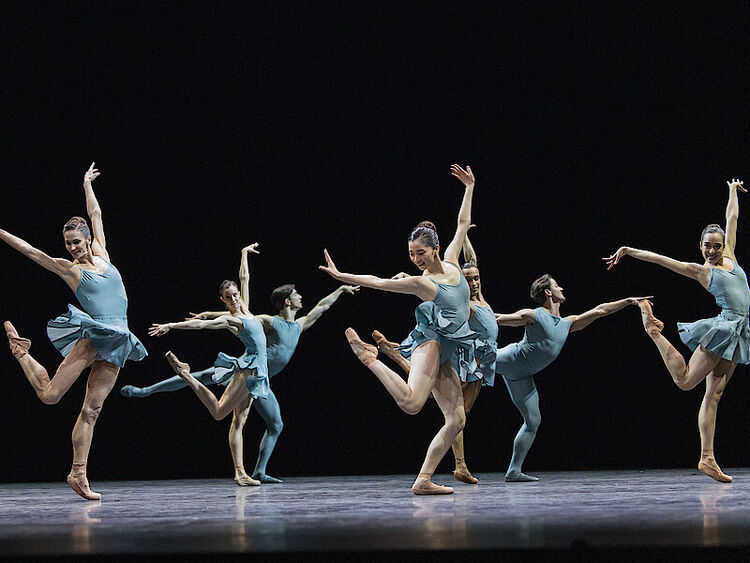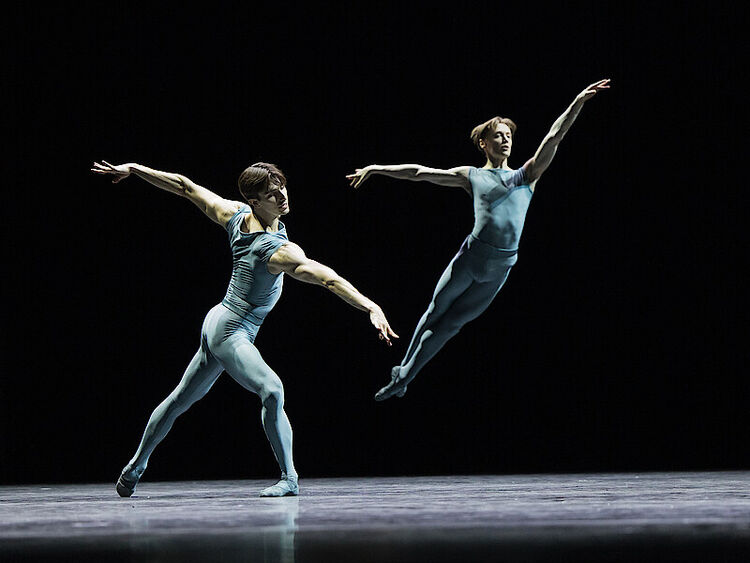Have you ever had that feeling when you’re at a party and your favourite DJ drops one great track after another and you never want to go home? Well, something similar happened to me during the Berlin Forsythe premiere, from the dancing over tables, to the abrasive music and the Staatsballett ensemble dancers having (a lot of) fun on stage.
Attending this premiere was like taking a journey through the history of twenty-century ballet, up to its present and its possible future. By ‘journey’ I don't just mean an erudite excursion into the knowledge of ancient artefacts, or simply discovering new things. Above all, I mean savouring that joy, that exhilaration, that feeling that doesn't let you sleep at night because you know that, whatever happens, you’ll remember it forever.
Forsythe's choreographic career, spanning some fifty years, has been characterised by multidisciplinary and analytical research of dance, focusing on the deconstruction and reconstruction of ballet language, the development of improvisational and compositional technologies, and the more recent creation of choreographic objects, a form of democratic playground that invites audiences to interact and negotiate.

A flow of breathtaking physical and visual emotions
Approximate Sonata 2016, named in part after the musical composition, is a piece from 1996, reassembled, revisited, and staged here in the version that Forsythe created for the Paris Opera Ballet in 2016. The audience is welcomed into the theatre auditorium by Thom Willems’ wave-like music even before the curtain opens. As the audience sits and chats, the echo of these sound waves can be heard, as if to create a sound carpet. It is not clear what it is, perhaps an extended heart beat, or the sound of ice, like glaciers breaking. The staged set appears in various shades of grey and looks industrial, with a ‘ja’ sign hanging on one side. The piece starts with a female/male duet, the ballerina in a black leotard and the male dancer in black leggings and tank top. As the choreography evolves, eight dancers appear on stage, mainly organised into four duets. The black and grey tones of the staging are broken up by the fluorescent addition of the costumes, such as the fuchsia camisole and the electric blue trousers.
By letting us see the ballet structure, which comprises many off-axes, vertiginous turns, dynamic and tight holds, the pas de deux appear strongly icy and analytical. The end reprises the beginning, with the same couple on stage, but this time they are talking, as if they were discussing the multiple possibilities of the use of pointe shoes during rehearsals.

The second piece, One Flat Thing, reproduced (2000; released as a dance film by Thierry de Mey in 2006) is again set to Willems’s almost noise-like soundscape. It features fourteen dancers and twenty tables, arranged into five rows with very little space between them. Being seated at the very front, my view was perhaps impaired since, given how close I was, I could not see the whole scene. At the same time, this perspective was effective. With the tables very close together, it was as if I had two perspectives, distinct, almost, and cut off by the line of sight constructed by the tables, leaving me with that which happens above and that which happens below the tables. The dancers, dressed in rehearsal-like clothing, give each other input, mostly in pairs. They jump over the tables and stretch out along them. Eventually they push them all upstage, generating noise upon noise.
Quoting Forsythe himself, One Flat Thing, reproduced is “like an orchestra with all the musicians conducting it.” The perspective of this piece is not classical frontal but moves across multiple focal points. Here, each dancer provides specific movement keys, communicating with their colleagues in a piece of composition where the agency of each dancer stands out.
Going back to move forwards
Finally, Blake Works I, is like watching a very ‘classical’ ballet executed at incredible speed, set to the pop music of British singer and musician James Blake. The piece’s vocabulary draws on the French ballet school and makes use of many of the demanding intricacies of that particular style. Moreover, it contains some iconic fragments and quotes from ballet performances.

Seeing this piece, I better understand what Forsythe meant in his introductory discussion with Staatsballett’s director Christian Spuck when he said that “everything is in the épaulement”. It is all about how the body is arranged in space and how and why it changes in step with the tempo. Indeed, it seems that it is precisely through a specificity in the use of épaulement that the dancers manage to cut through space in a clinical and dynamic manner.
With ballerinas in light blue leotards and short skirts, and male dancers in semi-sheer t-shirts (except for one in rehearsal clothes, maybe in the role of choreographer?), we experience duets, solos, groups, all in a dizzying, dynamic vertigo. By means of real-life challenges on the stage, such as who can do the most complex batterie sequences and multiple entrechats, it looks like the dancers are not just asked to do it faster, but are challenged to take it upon themselves to find ways to speed it up in real time during the performance. The dancers are relaxed and on edge at the same time.

If this piece is 'easier' to listen to musically when compared to the previous two tracks, it is because it is more melodic. At a ballet language level it is like seeing an encyclopaedia of ballet through VR glasses, everything ballet does, has done and can do. Quoting Forsythe, “it’s ballet, ballet, with ballet on top.” Blake's music has quite a melancholic tone and was released on the album entitled The Colour in Anything (2016). Another of Blake’s albums which somehow echoes this gloomy soundscape, is the eponymous James Blake (2011), especially the song Limit to Your Love. But in Forsythe's work there is no limit to his love for ballet.
When re-staging his work, Forsythe never intends for them to be the same as previous versions, but always rewrites them for the current bodies, putting his work in the hands and agency of the dancers present. Attending this evening made me think about the issues surrounding the living archive, a much-discussed and much-researched issue within the dance studies field today. What happens to the archive when it is restructured, reassembled, and re-evaluated according to specific artists? What arises when one reinterprets the archive in the spirit of the time of its construction, but rewriting it from today’s perspective? What happens when an archive is put back into the interface of the dancers and their agency?
Written from the première of the performance of 16 February 2024 at Deutsche Oper, Berlin.
William Forsythe
Approximate Sonata 2016
Choreography: William Forsythe
Music: Thom Willems
Stage and light design: William Forsythe
Costumes: Stephen Galloway
Staged by: Stefanie Arndt / Thierry Guiderdoni
Stage and lighting supervisor: Tanja Rühl
Sound supervisor: Niels Lanz
World première: 20 January 1996, Ballett Frankfurt, Opernhaus Frankfurt / Première of the revised version Approximate Sonata 2016: 4 Juli 2016, The Paris Opera Ballet Palais Garnier Paris
One Flat Thing, reproduced
Choreography: William Forsythe
Music: Thom Willems
Performed live by: Niels Mudde
Stage and light design: William Forsythe
Costumes: Stephen Galloway
Staged by: Thierry Guiderdoni, Ayman Harper, Eva Dewaele, Alexandre Simões
Stage and lighting supervisor: Tanja Rühl
Sound supervisor: Niels Mudde
World première: 2 February 2000, Ballett Frankfurt, Bockenheimer Depot Frankfurt
Blake Works I
Choreography: William Forsythe
Music: James Blake
Stage design: William Forsythe
Light design: Tanja Rühl
Costumes: Dorothee Merg / William Forsythe
Staged by: Stefanie Arndt / Ayman Harper / Yannick Sempey
Stage and lighting supervisor: Tanja Rühl
Sound supervisor: Niels Lanz
World première: 4 July 2016, Paris Opera Ballet, Palais Garnier Paris








